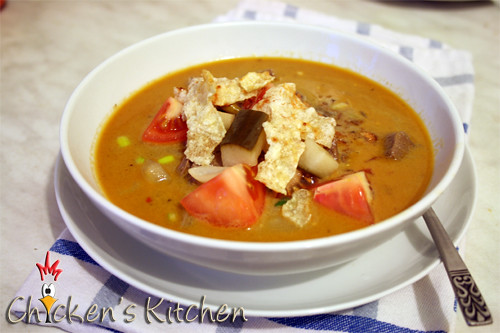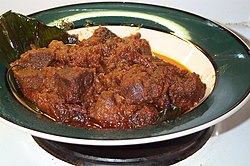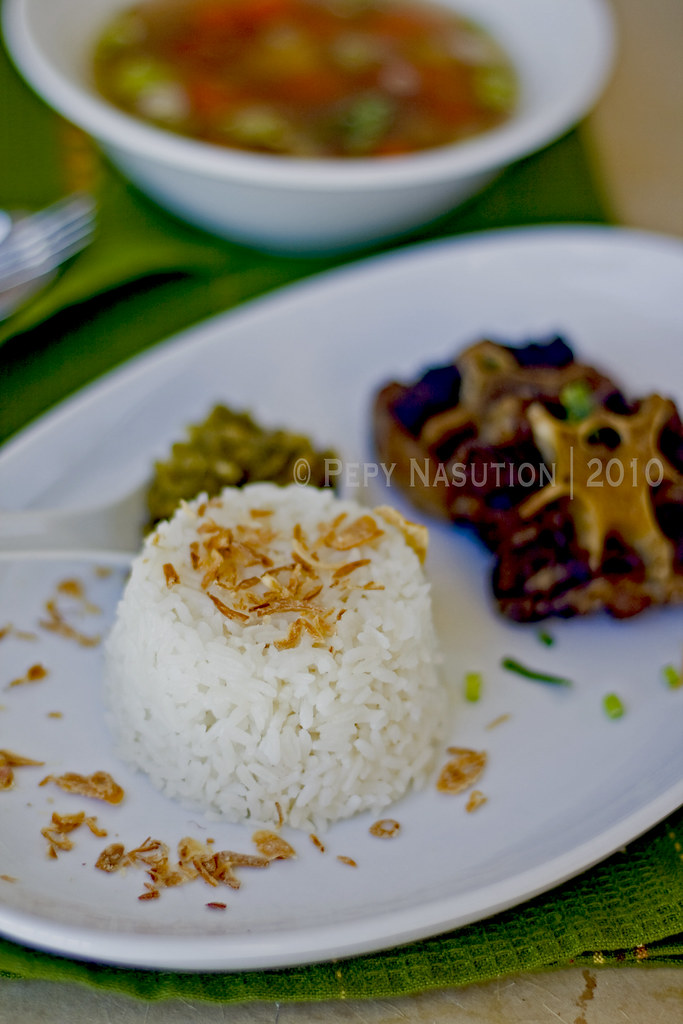People may be known this as satay, but we spelled this out “sate” and pronounce as “saté”. There are many varieties of sate in Indonesia; peanut, sweet soy sauce or curry base. Sate Padang is one that has curry base sauce. It consists similarity to Minangese rendang spices, turmeric leaves and other spices.
Based on Sefa’s blog, there are three different variant of Sate in West Sumatra; Sate Pariaman and Sate Padang Panjang. Those two are named after the cities in that province. However, it’s commonly called Sate Padang as Padang is the capital city of West Sumatra.
All is made from oxtongue and beef, but they have a different sauce. Sate Padang has a thick and very hot sauce or gravy due to peanuts and ample chilies. Also, Sate Padang has a combination taste of Sate Pariaman and Padang Panjang. While Sate Pariaman has red gravy, Sate Padang Panjang has yellow one.
Sate Padang
- Padangese Sate -
Recipe from different various sources on the Internet and modified by me
- Padangese Sate -
Recipe from different various sources on the Internet and modified by me
Ingredients:
908 g (2 lbs) oxtongue (or beef or combination of two)
8 kaffir lime leaves
2 stalks of lemongrass, take only the white part, bruised
1 turmeric leaves, knotted (optional)
2 asam kandis (I substituted for kokam or gorakha, it can be found at Indian/Caribbean markets)
water for boiling ox tongue
bamboo skewers
cooking oil
½ – ¾ cup rice flour, dissolved in a small amount of water
908 g (2 lbs) oxtongue (or beef or combination of two)
8 kaffir lime leaves
2 stalks of lemongrass, take only the white part, bruised
1 turmeric leaves, knotted (optional)
2 asam kandis (I substituted for kokam or gorakha, it can be found at Indian/Caribbean markets)
water for boiling ox tongue
bamboo skewers
cooking oil
½ – ¾ cup rice flour, dissolved in a small amount of water
Spices to grind:
7 shallots
3 cloves garlic
red cayenne peppers (I substitute for ground chilies as many as you can handle the hot flavour)
3 cm long galangal
2 cm long ginger
2 cardamoms
1 tsp ground coriander
½ tsp cumin powder
2 tsp curry powder (I prefer the Srilankan curry powder)
ground white pepper and salt as needed
7 shallots
3 cloves garlic
red cayenne peppers (I substitute for ground chilies as many as you can handle the hot flavour)
3 cm long galangal
2 cm long ginger
2 cardamoms
1 tsp ground coriander
½ tsp cumin powder
2 tsp curry powder (I prefer the Srilankan curry powder)
ground white pepper and salt as needed
Condiments:
rice cake (ketupat)
fried shallots (bawang goreng)
rice cake (ketupat)
fried shallots (bawang goreng)
Directions:
1. In a pot, add water and bring to a boil. Add oxtongue, cook for about next 15 minutes.
1. In a pot, add water and bring to a boil. Add oxtongue, cook for about next 15 minutes.
2. Remove ox tongue from the pot and save 750 mL of the liquid. Scrape the ox tongue with a knife. Rinse well under running water. Cut into cubes (1x2x1 cm3).
3. In the same pot, combine 750 mL liquid, ox tongue cubes, ground spices, turmeric leaves, kaffir lime leaves, lemongrass, asam kandis and salt. Bring into a boil then reduce the heat, simmer until the tongue completely cooked.
4. Thread 4-5 pieces of tongue into each skewer. Brush with a small amount of cooking oil and grill couple of minutes until both sides are brown (do not grill too long as ox tongue is already cooked).
Gravy:
1. Simmer the broth.
2. Gradually pour into rice flour mixture while stirring.
3. Keep stirring until the gravy thickens.
1. Simmer the broth.
2. Gradually pour into rice flour mixture while stirring.
3. Keep stirring until the gravy thickens.
Serving Suggestion:
Place Sate Padang and rice cake on the plate. Pour the gravy over and garnish with fried shallots. Serve while it’s still hot.
Note: If you are using beef, you don’t need to boil with water first. Cut the the beef into cubes, combine with water and spices and boil.
Place Sate Padang and rice cake on the plate. Pour the gravy over and garnish with fried shallots. Serve while it’s still hot.
Note: If you are using beef, you don’t need to boil with water first. Cut the the beef into cubes, combine with water and spices and boil.
http://indonesiaeats.com/sate-padang-padang-satay/











































 BASIL (daun selasih, daun kemangi): Two varieties of this fragrant herb are found in Indonesia. They are generally added to dishes at the last minute for maximum flavour. daun kemangi has a lemony scent, while daun selasih (identical to Thai horopa) is more similar to sweet European basil, which can be used as a subtitute.
BASIL (daun selasih, daun kemangi): Two varieties of this fragrant herb are found in Indonesia. They are generally added to dishes at the last minute for maximum flavour. daun kemangi has a lemony scent, while daun selasih (identical to Thai horopa) is more similar to sweet European basil, which can be used as a subtitute. 

 BILIMBI, SOUR (belimbing wuluh): This pale green acidic fruit about 5-8 cm (2-3 inchi) long, grows in clusters on a tree. A relative of the large, five-edged sweet starfruit, Bilimbi is used whole or sliced to give a sour tang to some soups, fish dishes and sambals. Sour grapefruit or tamarind juice can be used as subtitute.
BILIMBI, SOUR (belimbing wuluh): This pale green acidic fruit about 5-8 cm (2-3 inchi) long, grows in clusters on a tree. A relative of the large, five-edged sweet starfruit, Bilimbi is used whole or sliced to give a sour tang to some soups, fish dishes and sambals. Sour grapefruit or tamarind juice can be used as subtitute.  CARDAMOM (kapulaga): About 8-12 intensely fragrant black seeds are enclosed in a straw-coloured, fibrous pod. Try to buy the whole pod rather than cardamom seeds or powder for maximum flavour, and bruise lightly with the back of the cleaver to break the pod before adding to food.
CARDAMOM (kapulaga): About 8-12 intensely fragrant black seeds are enclosed in a straw-coloured, fibrous pod. Try to buy the whole pod rather than cardamom seeds or powder for maximum flavour, and bruise lightly with the back of the cleaver to break the pod before adding to food. CELERY (seledri): The celery used in Indonesia is different from normal western variety, with slender stems and particularly pungent leaves. It is often refereed to as 'Chinese celery' abroad and is used as a herb rather than vegetable.
CELERY (seledri): The celery used in Indonesia is different from normal western variety, with slender stems and particularly pungent leaves. It is often refereed to as 'Chinese celery' abroad and is used as a herb rather than vegetable.
 CHIVES, COARSE (Kucai): Coarse chives, flat leaves about 30 cm (12 in) long, are used as a seasoning; although the flavour is more delicate, spring onions (scallions) can be used as a subtitute.
CHIVES, COARSE (Kucai): Coarse chives, flat leaves about 30 cm (12 in) long, are used as a seasoning; although the flavour is more delicate, spring onions (scallions) can be used as a subtitute. CINNAMON (kayu manis): The thick, dark brown bark of a type cassia is used in Indonesia, not true cinnamon. The latter is more subtle in flavour and considerably more expensive. Always use whole bark, not ground cinnamon.
CINNAMON (kayu manis): The thick, dark brown bark of a type cassia is used in Indonesia, not true cinnamon. The latter is more subtle in flavour and considerably more expensive. Always use whole bark, not ground cinnamon. CLOVES (Cengkeh): This small, brown, nail shaped spice was once found only in the islands of Maluku. Cloves are used in cooking les frequently than one might expect, but add their characteristic fragrance to the clove scented cigarettes or kretek popular through out Indonesia.
CLOVES (Cengkeh): This small, brown, nail shaped spice was once found only in the islands of Maluku. Cloves are used in cooking les frequently than one might expect, but add their characteristic fragrance to the clove scented cigarettes or kretek popular through out Indonesia.

 CUMIN (jinten): Together with coriander and pepper, this small beige elongated seed is one of the most commontly used spices in Indonesia. Take care not to confuse it with fennel.
CUMIN (jinten): Together with coriander and pepper, this small beige elongated seed is one of the most commontly used spices in Indonesia. Take care not to confuse it with fennel. FENNEL (jinten manis): This seed is simiar to cumin, although slightly fatter, whiter, and with a distinctive fragrance reminiscent of aniseed.
FENNEL (jinten manis): This seed is simiar to cumin, although slightly fatter, whiter, and with a distinctive fragrance reminiscent of aniseed.